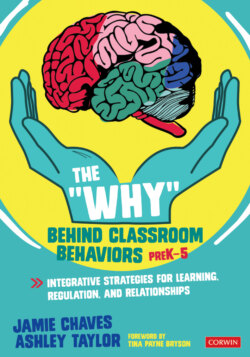Читать книгу The "Why" Behind Classroom Behaviors, PreK-5 - Jamie Chaves - Страница 14
На сайте Литреса книга снята с продажи.
Strategy 1: Engage in Positive, Regulating Experiences
ОглавлениеThe same concept of brain development, integration, and regulation is true for all of us: parents, professionals, and teachers. Just as children who have relationally safe and sensory-attuned environments are better able to regulate and learn, teachers who are regulated have a larger capacity to connect with students, engage in the joys of students’ learning, and feel energized about what they do. In this way, the IPNB framework and other relational models serve as a form of self-care, support, and understanding for educators. In order for a teacher to effectively co-regulate with a student, the teacher must first be regulated. Oftentimes, dysregulated adults cause a child to be more dysregulated as well, resulting in a cycle of co-dysregulation. This is why it is important that teachers feel supported and equipped to take on the daily challenges they face in the classroom. Teachers must be engaged in positive relationships with those around them every day, as well as engaged in regulating experiences throughout the day.
When we engage in positive, regulating experiences, this helps to facilitate an “integrated brain, empathic relationships, and coherent mind.” These regulating experiences can be small moments throughout the day, such as sitting with a cup of coffee in the morning, walking around the block on your lunch break, eating lunch with a favorite colleague, or writing in a journal a night. When chaos or rigidity takes over, it can negatively impact the way you interact with those around you—especially your students. If you start to experience more chaos or rigidity in your life, particularly related to teaching, it is likely that the integration of your brain/body, relationships, or mind is obstructed.
In his book, The Mindful Brain, Dr. Siegel states,
The human connections that help shape our neural connections are solely missing in modern life. We are not only losing opportunities to attune to each other, but the hectic lives many of us live leave little time for attuning to ourselves.10
It is therefore important that we not only focus our minds on ways to engage, attune, and connect with our students but spend time sending the flow of energy into connecting, engaging, and attuning with ourselves. By allowing ourselves this space, we will open the door to the endless potential of human capacity for compassion, empathy, and love, feel more successful in our lives but also support the next generation in becoming empathetic, compassionate, and loving adults.
